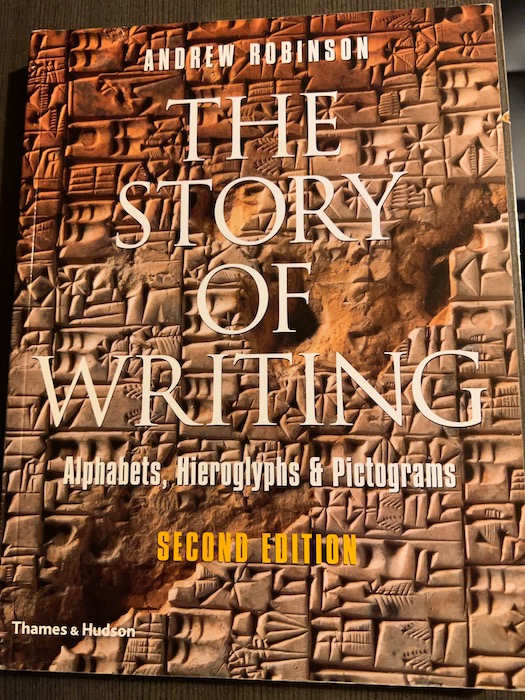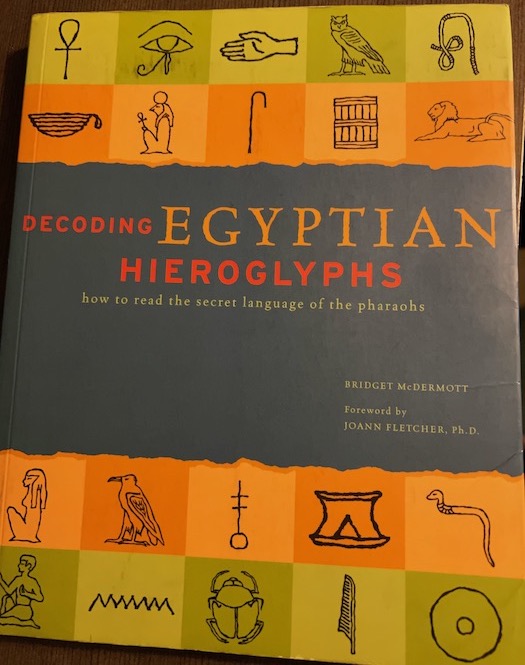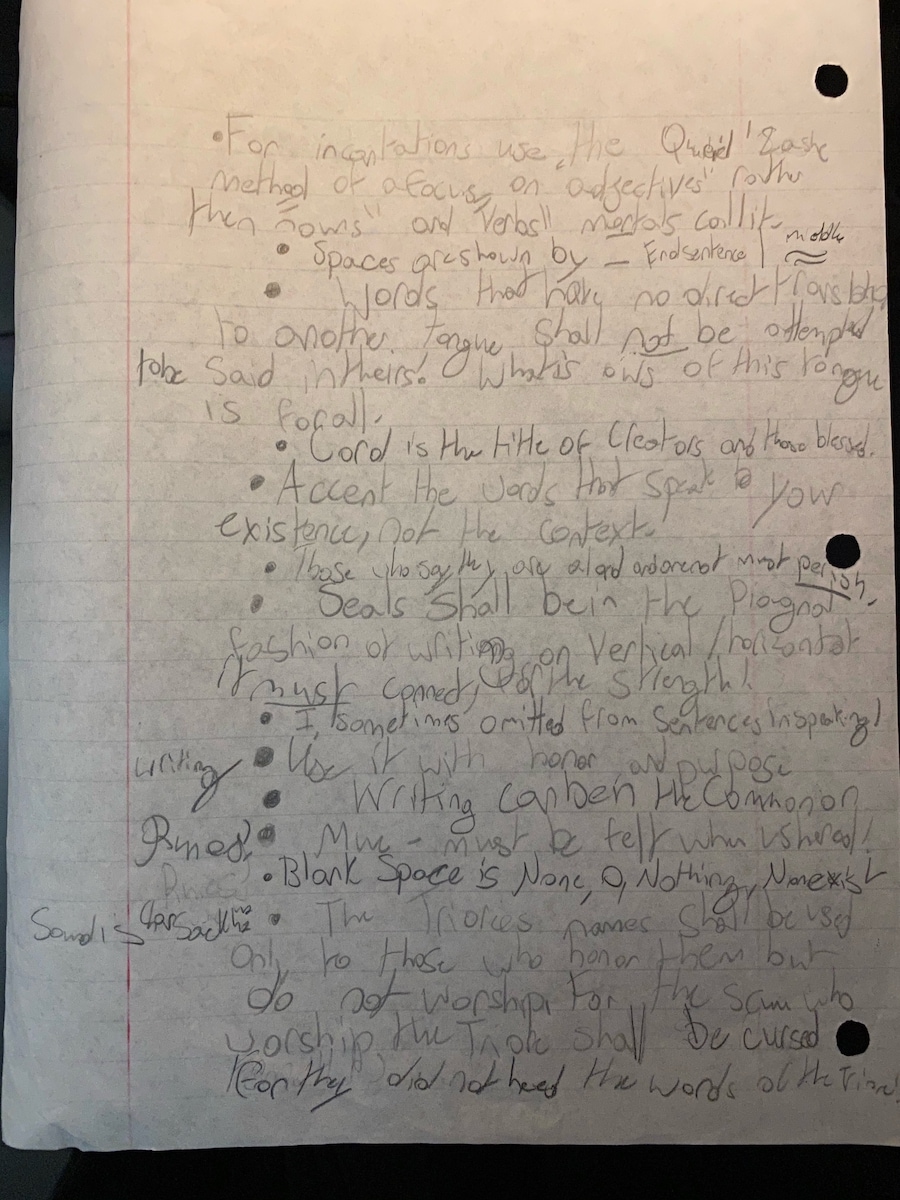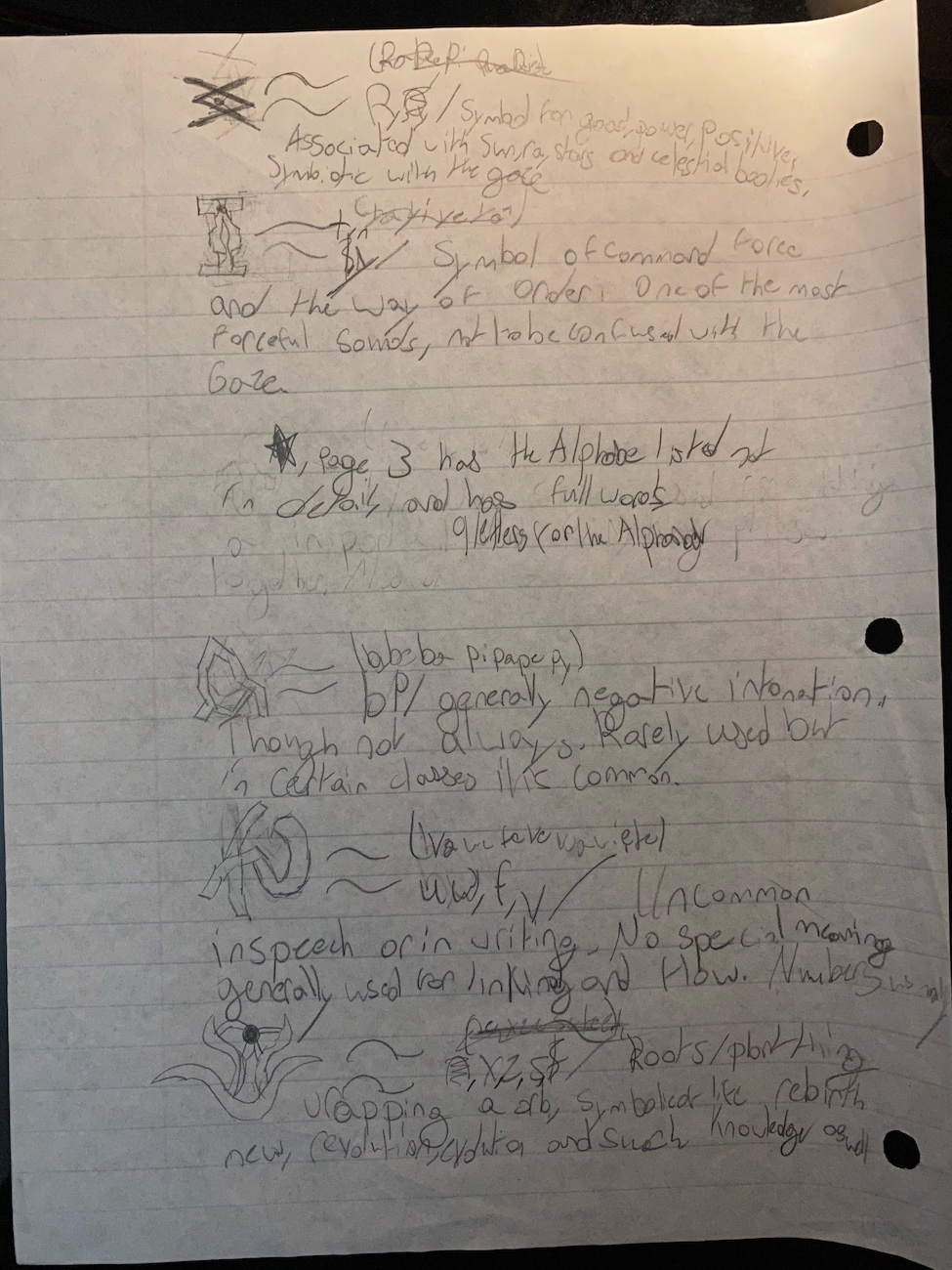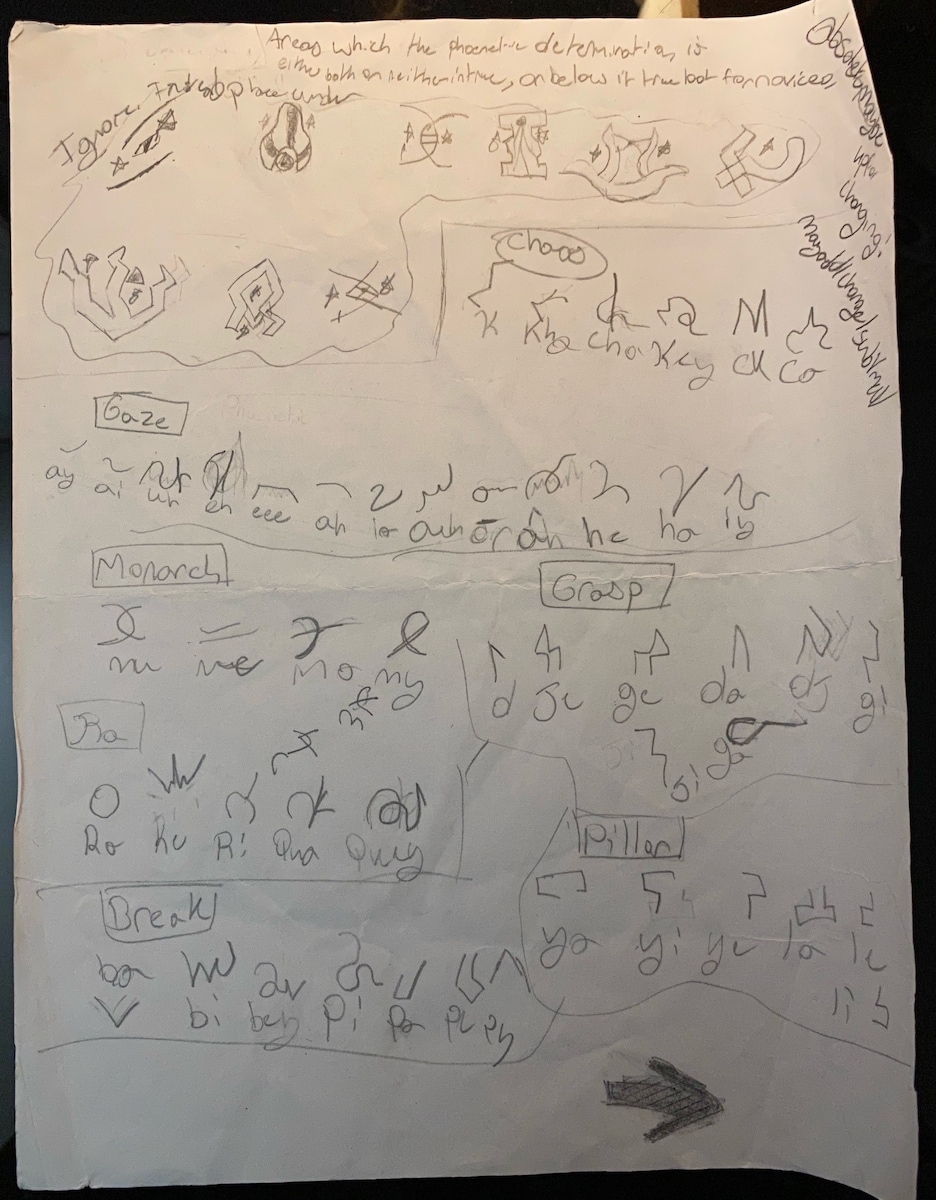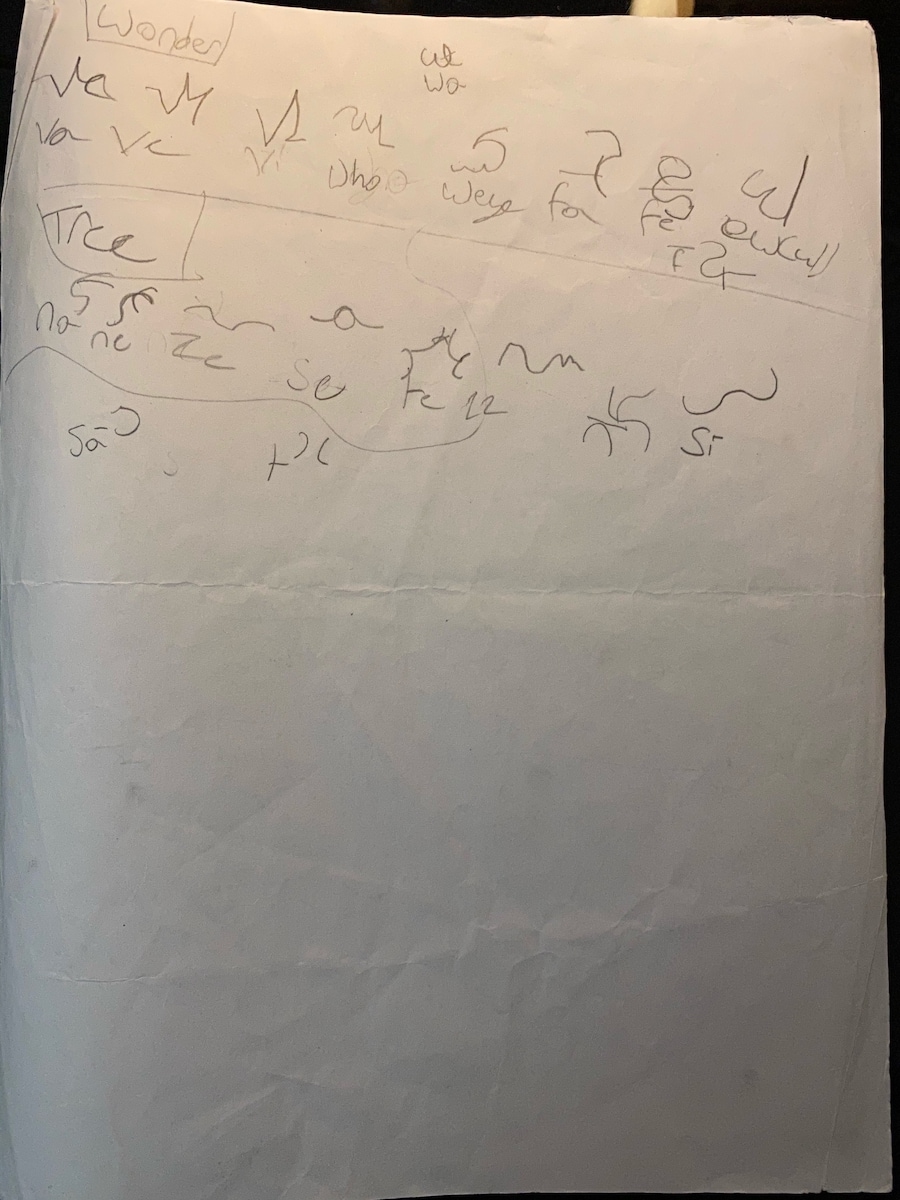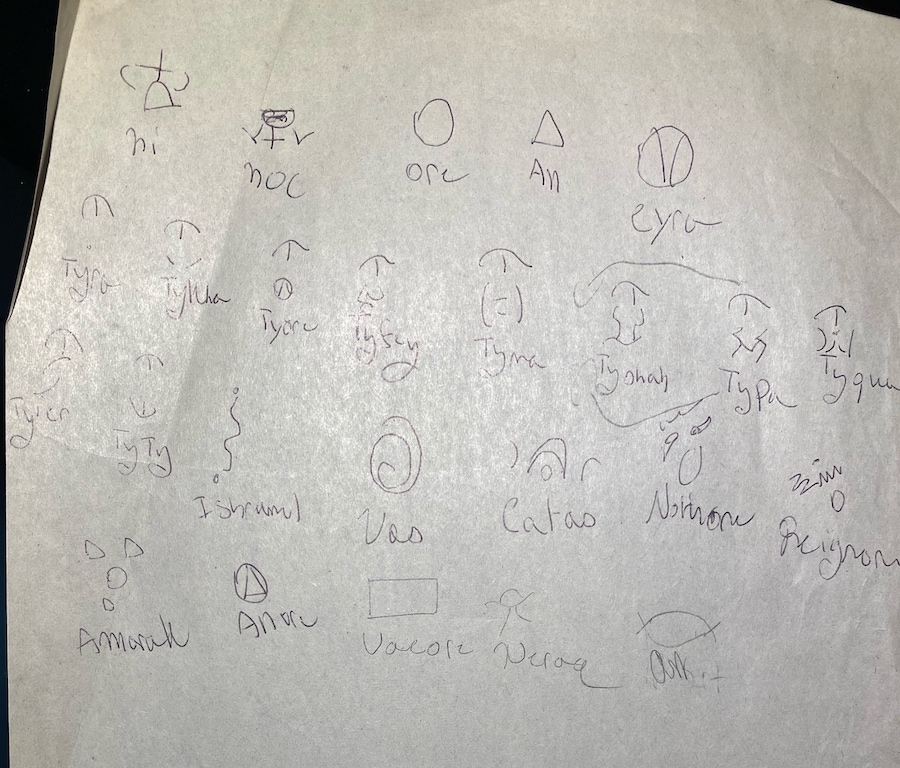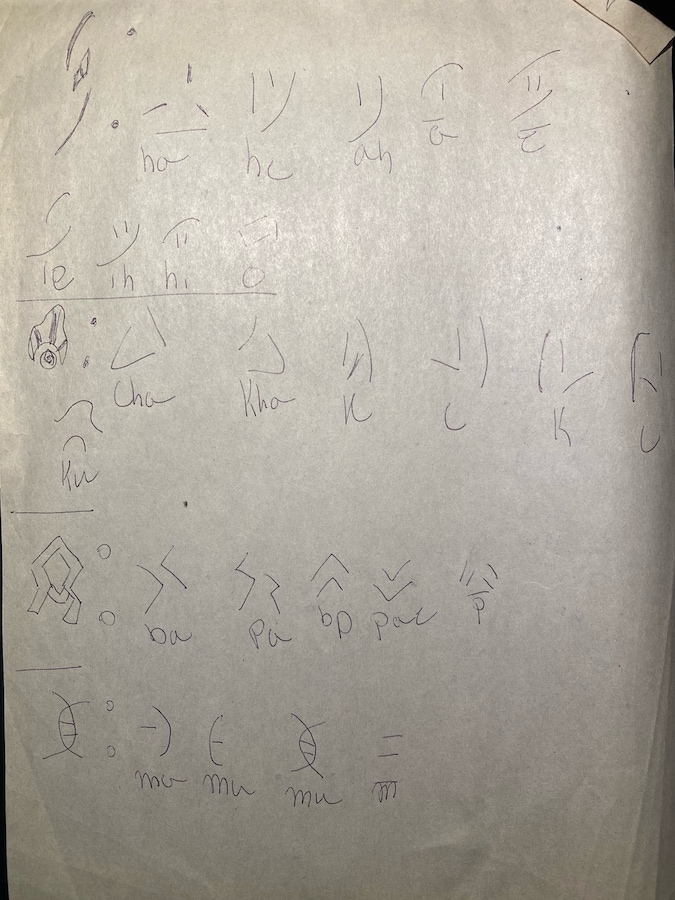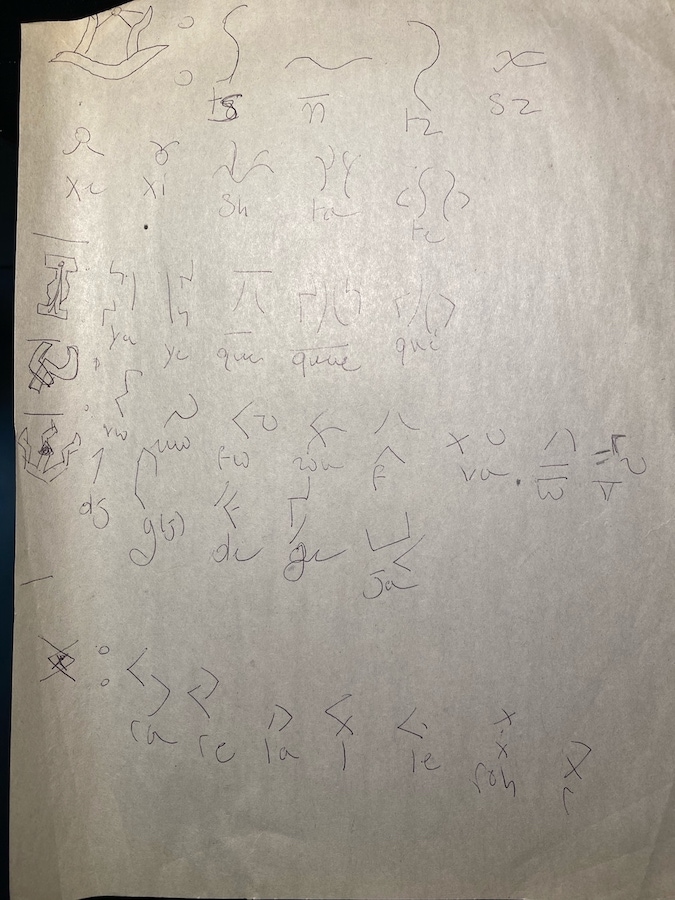Tyra Tarkush Development History
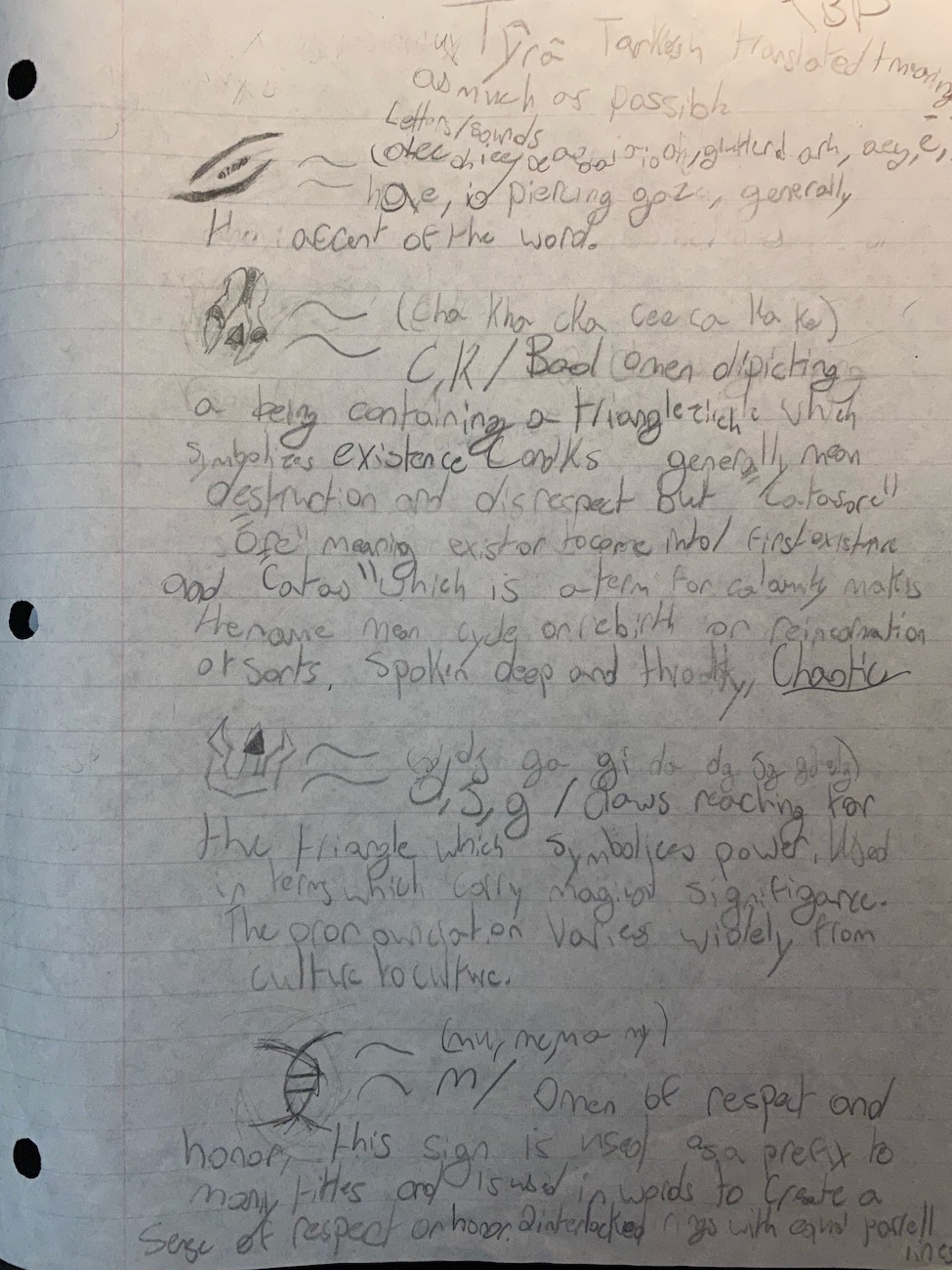
Tyra Tarkush is the language of the creators/my world. It has its own grammar, a large ever-growing lexicon of words, and its own script. It took a few iterations and effort to get to this coherent point.
This post is going to be my attempt to piece together the development history of Tyra Tarkush into some coherent groupings. I didn’t really date my notes/documents, so this is my best guess/recollection/general explanation of how Tyra Tarkush came about. It’s not in chronological order, but rather by concepts and development ‘thought processes’. This post does not share all of my notes, more like a reasonable selection of the madness. It is madness because I also went back and edited/tweaked some of them so probably none of them are in their original state. They were living documents at the time that were eventually labeled obsolete.
Note: If you can’t read my old handwriting on the docs, see transcriptions at the bottom of the post.
Anyway, here we…go…
Inspiration / Timing
I was very interested in linguistics due to reading The Story of Writing and Decoding Egyptian Hieroglyphs when I was much younger (this is how I remember getting interested in it, anyway). That interest/obsession I think funneled into Tyra Tarkush and was how I was quickly able to get sophisticated with the language development despite how young I was when I started developing it. Ancient Egyptian itself was a big inspiration and ‘starting’ point on how I planned to construct Tyra Tarkush too.
I will say that I believe that certain words and phrases and the idea of Tyra Tarkush existed before I actually made Tyra Tarkush. The above interest I believe like propelled me to actually make it a real language with proper rules–which led to changing some spellings/sounds of said words/phrases.
As for putting ‘dates’ around this process…ugh. I would say by 2014 at the latest it was basically locked in script/grammar wise and had a sophisticated lexicon. It seems like 2011 was the year I really invested time into fleshing it out. I’m not sure how much was finalized then and not between 2011 and 2014. I say 2014 as the ‘finalization’ end date because I have files of the font script from 2014. My oldest digital translation and phonetic guide files are dated 2015. It’s hard to tell years for certain, though, as I digitized what I was referring to on paper at some point around then (2014~2015 ish), and I probably went through multiple copies until I got things into a settled place, so…yeah. Approximate dates all around.
Regardless, for certain, Tyra Tarkush is over ten years old at this point, but has been stable for a very long time.
The Tongue of the Ancients / Original Overview
Tyra Tarkush was originally called the Tongue of the Trioré, or the Ancients, but soon was called Tyra Tarkush. I built out some core rules early on and cultural thinking:
Many of these concepts/rules still hold true:
- It being written in whatever direction
- How spaces are noted
- Lord as the title for the Creators
- Basically speaking with intent when using it
I was big on meaning and like the significance of the language. Which leads us to…
The Core Characters
The core nine characters/archetypes of Tyra Tarkush. These are the foundation of Tyra Tarkush. Each had unique meaning and had different sounds related to them (we’ll get to why in a bit).
Some things have been tweaked them meaning-wise and sound-wise, but in essence they are pretty constant. What has been not constant is how these characters relate to the written form of Tyra Tarkush.
The Scripts / Written Form / Alphabet
It took awhile to get to a stable written form. I had…ideas early on and then it quickly became clear what had to be done. I’m calling the alphabet the ‘script’.
Nine Letter Era
I think in an attempt to be profound or ‘special’ with my language, I started off by trying to only have nine letters (those nine characters up above). Each letter had multiple sounds attached to it and you would use the full character and like…somehow context was enough to explain which sounds to use in that context.
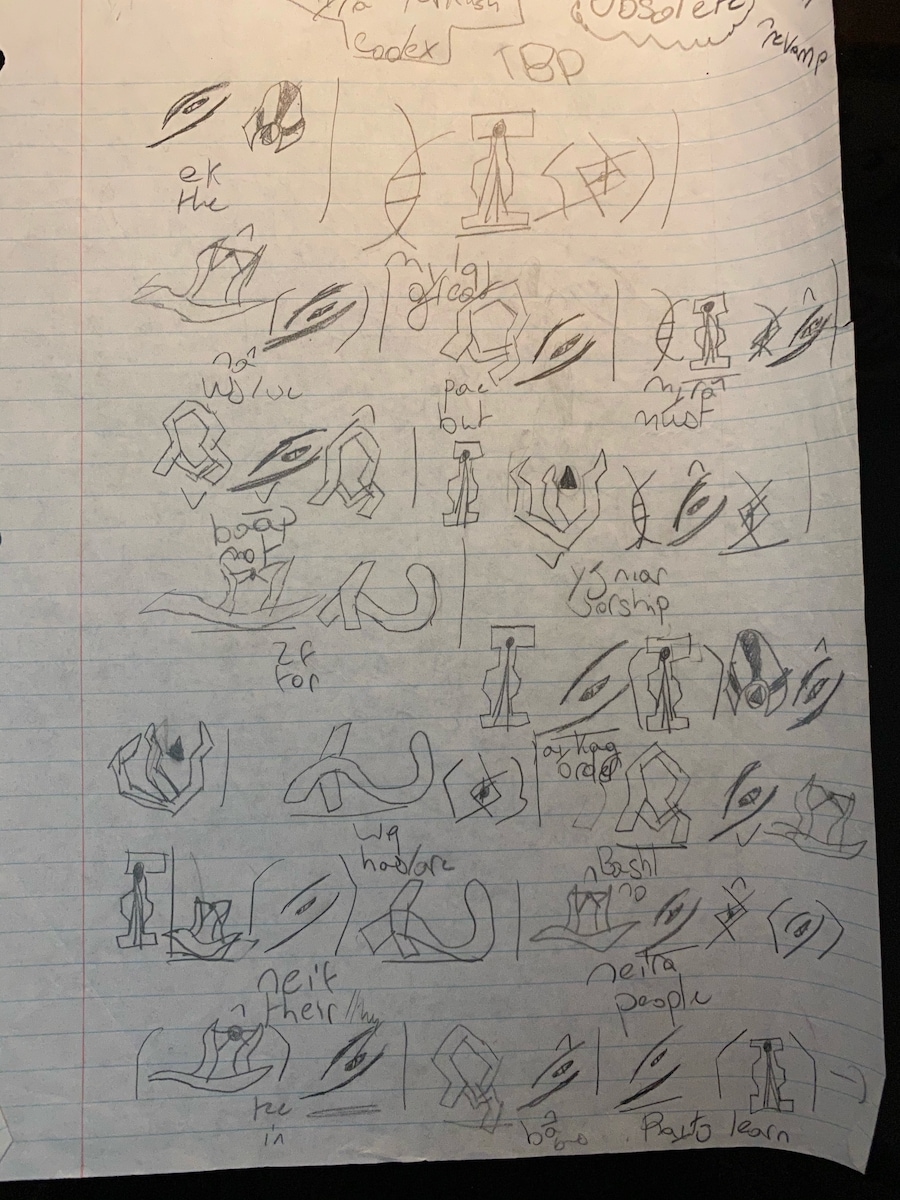
It…was out there and was not functional. I think I imagine intent/context would like be imparted from the script itself somehow.
Breaking it Down
So, given that I must have realized using nine letters was not a good idea or was pretty insane to lean into, I started making a phonetic script with more specific sounds attached to each character. Each phonetic character ‘belonged’ to one of the core nine and related to those sounds it had. This concept is how it works today/in canon.
This ‘version’ of the script looks very different than how it looks now. It’s very…cursive ish. It looks really foreign/off to me now.
Polishing
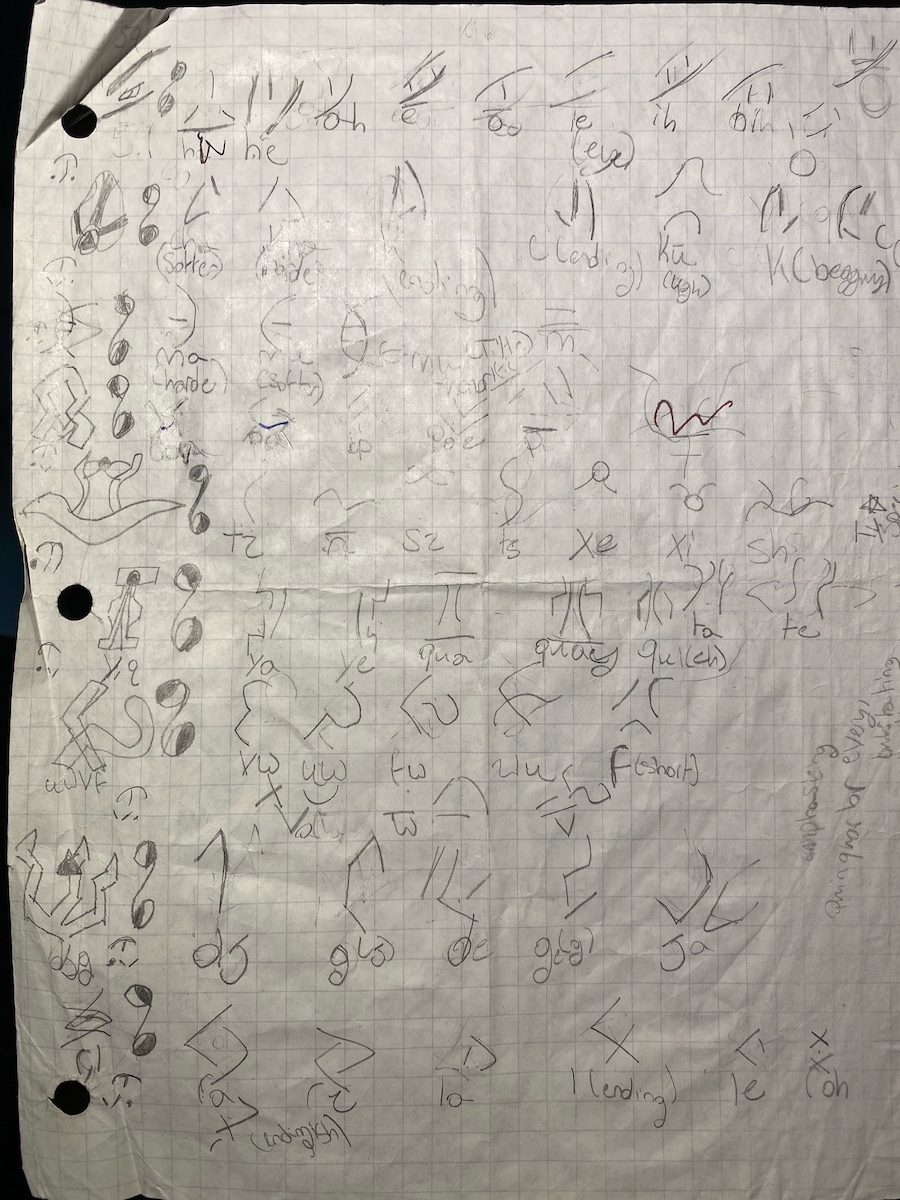
This is basically how Tyra Tarkush is now, with some adjustments. If I remember correctly, this was like my ‘source of truth’ with the script for some time. You can kind of see faded text/erased out ideas. The backside has unique symbols and the numbers (not pictured).
As such, I have a PDF of this page with ‘edits’ and changes done on top of it digitally. This is a picture of the actual page.
Below is a ‘cleaner’ version of this version (written on multiple pages on non-gridded paper):
Comment on the numbers: I switched the position of Typa and Tyshah. Basically Seven became Six. Hence the arrows.
Final Form
As for what the truly final version looks like: You can see the script incarnated in my custom font here. The biggest changes are related to the ‘Omen’ set. Two characters removed, one added.
Special Words / Zharziergush
Tyra Tarkush has a phonetic script but also has characters that mean specific, special things (these words are called Zharziergush). Like ‘Eyra’, meaning ‘I’, is written with a unique character. This is reserved for special/core ideas. Some of them are shown in the above script images.
Speaking of Eyra, though, here’s a picture of a clay jar/pot I made a long time ago with the drawing of Carathoukiea and Eyra on the side. Not shown, on the reverse, is the symbol for the Trioré.
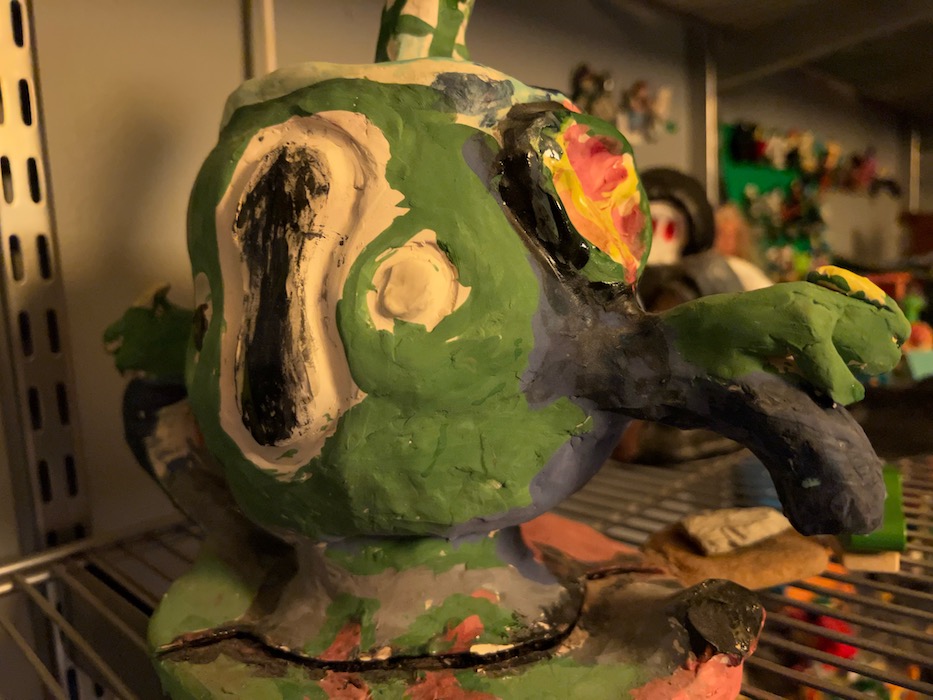
Word Order
The rough grammar is verb-subject-object. There’s the concept of ‘flanking’ words and phrases that surround the entire sentence. Adjectives follow what they describe, in specific orders. Questions have ‘ishramel’ as a flanking word and ‘si’ as the ‘unknown’ being questioned but can also be a placeholder.
I’m not sure how I came up with the flanking concept.
Conclusion
Tyra Tarkush had an interesting process coming together, but it’s together now and it works. I’m proud of how it sounds, looks, and how it functions. It just feels so right. I learned a lot from doing it and it’s one of my proudest world building achievements that came about post-childhood.
* Transcriptions of Above Documents
Old Overview
Italics are my comments.
Scribbles on the left margin of the first page look like grammar notes.
The tongue of the Triore or the ‘Ancients’ is common in Bothaenia and some of Caracakho but not used as much in Bahuckihea. Most of Tyra Kolaq’blegae uses it as a way to meddle with humans but it is used as ‘code’ in war. Scare are the Kolaq’blegae that use this tongue but in in those areas it is revered.
Spoken with haste and strong emotional undertones, Tyra Tarkush is used to paint a distinct image and feeling for the listener rather than just converted concepts. Few words cannot be even translated to the common tongues. To the untrained ear it is ?? and howling but to those who heed the whispers, it is a symphony of emotions.
Many rules apply to the spoken and written of this fluid language. Here they are:
- Any direction to be read for speaking it is done regionally and interchangeable though the ‘Human’ way is most commonly used for comic reasons. (I don’t know what this means anymore.)
- Punctuation is breath.
- For incantations use the Queiel’Zash method of a focus on “adjectives” rather than “nouns” and “verbs” mortals call it. (No idea, I think this is like focusing on impact of spells rather than the tangibles.)
- Spaces are shown by [describes the punctuation symbols]
- Words that have no direct translation to another tongue shall not be attempted to be said in theirs! What is ours of this tongue is for all.
- Lord is the title of Creators and those blessed.
- Accent the words that speak to your existence, not the context.
- Those who say they are a lord and are not must perish.
- Seals shall be in the Diagonal fashion of writing on vertical/horizontal, it must connect for the strength.
- ‘I’ sometimes omitted from sentences in speaking / writing
- Use it with honor and purpose
- Writing can be in the common runes.
- Mu - must be felt when ushered [uttered]!
- Blank space is None, 0, Nothing, Nonexistent
- The Triores names shall b used only to those who honor them but do not worship For the scum who worship the Triore shall be cursed for they did not heed the words of the Triore!
Old Character Meanings
- Gaze - h, a, e, i, o / Piercing gaze, generally the accent of the word.
- Omen - C,K / Bad omen depicting a being containing a triangle - circle which symbolizes existence. C and Ks generally mean destruction and disrespect but “Catasore” “ore” meaning existence to come into / first existence and “Catas” which is a term for calamity makes Her name mean cycle or rebirth or reincarnation of sorts. Spoken deep and throaty. Chaotic.
- Grasp - d, j, g / Claws reaching for the triangle which symbolizes power. Used in terms which carry magical significance. The pronounciation varies widely from culture to culture
- Monarch - M / Omen of respect and honor. This sign is used as a prefix to many titles and is used in words to create a sense of respect or honor. 2 Interlocked rings with equal parallel lines.
- Sun - R / Symbol of good, power, positive. Associated with sun, ra, stars and celestial bodies. Symbiotic with the gaze.
- Pillar - y (??) / Symbol of command force and the way of order. One of the most powerful sounds, not to be confused with the gaze.
Text of no consequence
- Break - bP / generally negative intonation. Though not always. Rarely used but in certain classes it is common.
- Wonder - u, w, f, v / Uncommon in speech or in writing. No special meaning. Generally used for linking and flow. ???
- Tree - x, z, s ? / Roots/plant thing wrapping a orb, symbolic of life rebirth, new, revolution, evolution and such knowledge as well.
Related/Recent Posts
Short Story on The Beginning of Mechanicha
‘The Liberation’ is the other ‘past’ short story contained in the compilation file I talked about here. Its history is more complex than the End of the Second story, though.
Short Story on The End of the Second Generation Humans
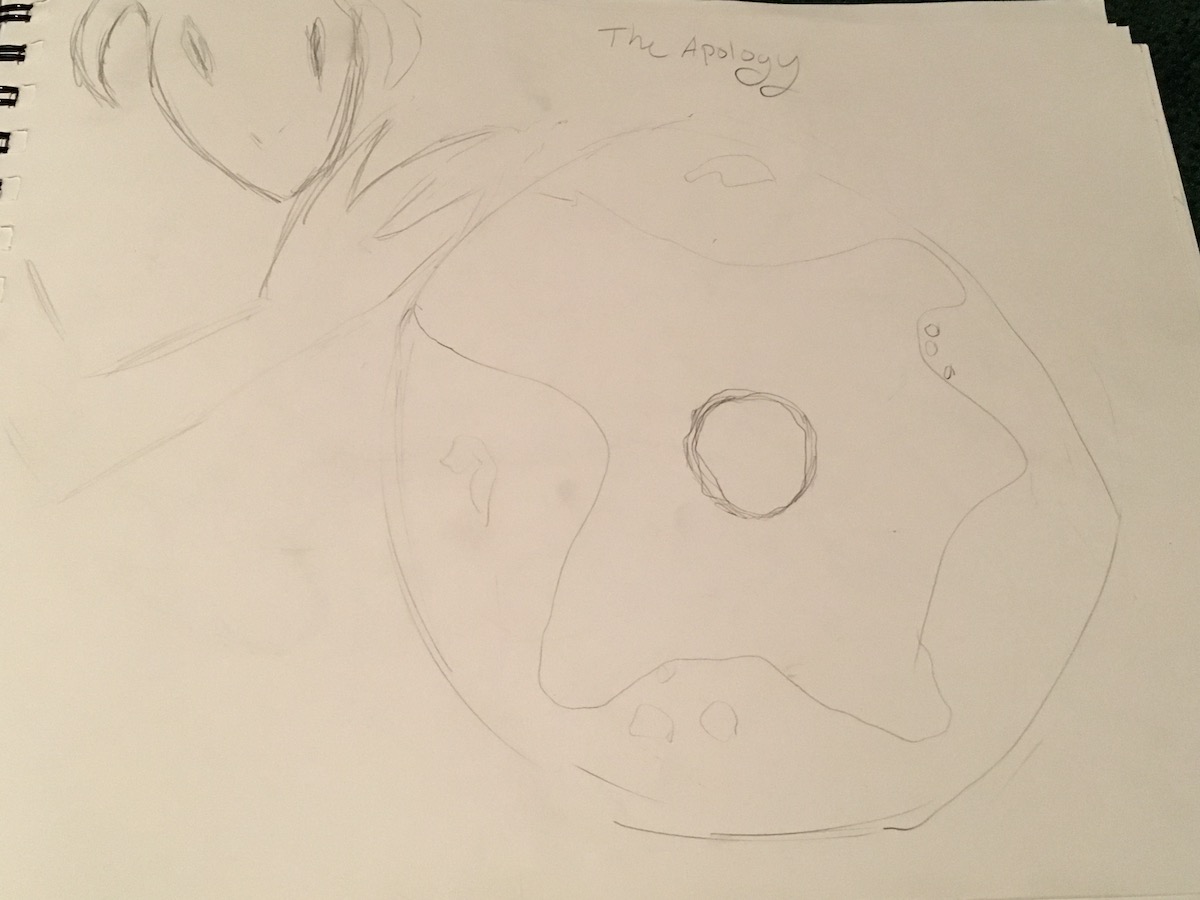
Another new short story! But it is not new. I originally wrote this scene in ~2015 in a compilation file containing three (including this) random world event stories plus a chapter titled Malechak with no content…which was intended to basically be ‘To Steal a Race with a Race’. I recently decided I was going to try to wrap up as many of these random half-finished/sketch-like stories as I could before I started fully on book 11, so I with this...

